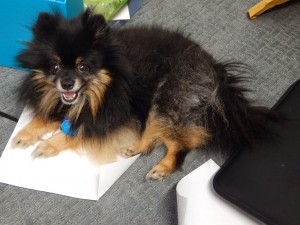Circling Around
As usual when we work on the outside of the house its decided to rain. But, the colours are right! The house is a light turquoise the studio darker both with plum coloured trim and and beautiful blue doors for luck. The metal gates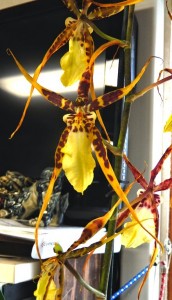 will each be a different colour.
will each be a different colour.
I have so much to do this week. I have a student coming to stay a week in the studio for tapestry lessons-exciting one of my favourite things to do.
I am working on a new piece about my two radically different Grandmothers. I am also trying to get together a book called— of course–
Soumack and friends.
When my student leaves. I leave the next day to teach in Prescott Arizona at Mountains spinners and Weavers guild. I understand there are still a few spots open. Then I’ll spend several days weaving with  friends in Santa Fe and move on to the next weekend teaching at Village Wools in Albuquerque, N. M. I am teaching a class called Soumack and Tapestry Friends. Yes it does deal with using Soumack architecturally to control angles and curves and circles-well any geometric shape.It’s one of my favourite classes to teach-I think because it has so much to do with drawing in tapestry. I love making lines go any direction I want, the architectural nature of soumack and friends, and of course, rya and related techniques.
friends in Santa Fe and move on to the next weekend teaching at Village Wools in Albuquerque, N. M. I am teaching a class called Soumack and Tapestry Friends. Yes it does deal with using Soumack architecturally to control angles and curves and circles-well any geometric shape.It’s one of my favourite classes to teach-I think because it has so much to do with drawing in tapestry. I love making lines go any direction I want, the architectural nature of soumack and friends, and of course, rya and related techniques. 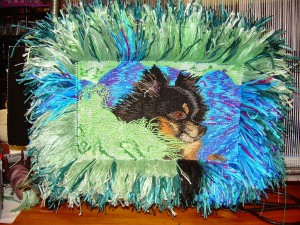 I have been asked several times if I will ever teach an on-line class on these techniques. My answer is no. I don’t enjoy teaching on line and there are others such as Rebecca Metzoff that enjoy it and do it well. I doubt she will offer this specific class, but I am sure she has many fine classes. I just prefer to do it in workshops, one on one, and face to face. So if you want to take this class from me you’ll need to travel to a workshop or my studio. I am offering this class on Valentines day in my studio in Albany, OR. Private students can even stay in my home while they study at the studio.
I have been asked several times if I will ever teach an on-line class on these techniques. My answer is no. I don’t enjoy teaching on line and there are others such as Rebecca Metzoff that enjoy it and do it well. I doubt she will offer this specific class, but I am sure she has many fine classes. I just prefer to do it in workshops, one on one, and face to face. So if you want to take this class from me you’ll need to travel to a workshop or my studio. I am offering this class on Valentines day in my studio in Albany, OR. Private students can even stay in my home while they study at the studio.
Okay- here’s my promise kept on writing about circles and stuff. . One caveat there is much more information in Tapestry 101. Much more about trouble shooting circles and more about technique.
First a couple of Caveats-There are two things I tell my students constantly.
One- there are no tapestry police.
If you do something oddly or differently no one is going to take your loom away and tell say you can’t weave tapestry. There are a hundred different ways to do most things and none is right or wrong if it gets the job done and you like the end results. BUT,
Secondly don’t dumb down and make design decisions because you think you can’t do something.
If you want to simplify a design or misshape something, do it because you choose too. Not because you have to! Figure it out and weave what you like. Look up techniques, ask questions, but don’t say-o, well, it’s just the nature of tapestry. It’s not! Tapestry is about fooling the eye. Tapestry is all about how to weave 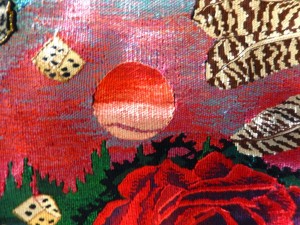 your design and make it look like what you want. If you want round circles without stair steps it can be done.
your design and make it look like what you want. If you want round circles without stair steps it can be done.
don’t make or justify decisions by saying it’s kelimesque or that your copying another cultures design sensibilities to make up for mistakes in the design and weaving-especially when it comes to circles that culture very seldom if ever uses. Very view kelims have circles-ever. Own up and fix it and then choose to it the way you want to make it look!
That said, I want to write about circles, curves and angles without teeth or stair steps.
1. Know the geometry of the shape or curve or angle you wish to weave. If you need to draw the shape out on graph paper. Do it! It’s not cheating! Because you are after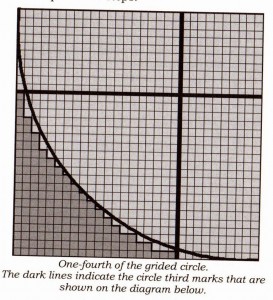 all weaving on a grid. Once you reduce a geometric shape to a drawing on graph paper you become aware of how it works if you weave straight passes. You’ll see the stair steps and the sizes they need to be.
all weaving on a grid. Once you reduce a geometric shape to a drawing on graph paper you become aware of how it works if you weave straight passes. You’ll see the stair steps and the sizes they need to be.
Lets use a circle as an example. Use a template to draw a circle on a piece of graph paper. You’ll see that the sides raise with a variety of different sized stair steps and pass widths.
circle on a piece of graph paper. You’ll see that the sides raise with a variety of different sized stair steps and pass widths.
Quarter the circle . You’ll have 4 pieces of a pie. What you’ll find is each of those pieces equals the other the other 3 pieces of the pie. AND, will be almost identical in the way they ascend or descend in stair steps. You also should note that because your working on a grid that there are 4 areas that will be basically flat-top, bottom and 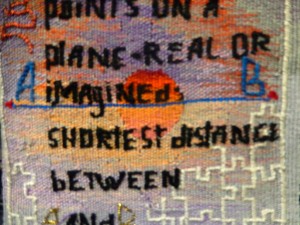 the two sides. if you look carefully they each equal about a third of the width AND/OR length of the circle.
the two sides. if you look carefully they each equal about a third of the width AND/OR length of the circle.
Then, look again, the next step over will be about one/ sixth of the flat area. The steps become smaller as you move over and up. At about one half the the climb of the first quarter of the pie you start to duplicate in reverse the sizes of the stair steps of the climb until you are matching in the rise the size of the beginning stair steps. The last stair step before the side flat area on each side is 1/3 of the the bottom and side flat areas. The two bottom sides of the circle are identical.
Each of the 4 pieces of the pie will be woven in the same way with the s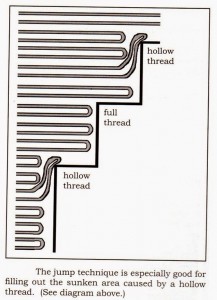 ame number of stair steps and overs. The possible exception that one passes d
ame number of stair steps and overs. The possible exception that one passes d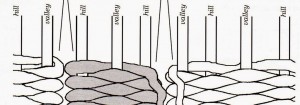 oes not always equal another pass in a turn. IF you turn on a hollow thread it will take more passes to equal those then turns on a full thread.(Hollow or Valley thread and full and hill are often used interchangeably when describing this Phenomena)
oes not always equal another pass in a turn. IF you turn on a hollow thread it will take more passes to equal those then turns on a full thread.(Hollow or Valley thread and full and hill are often used interchangeably when describing this Phenomena)
The top half of the circle is usually woven about 5 percent higher so that as the circle is beaten on and over it doesn’t squish the circle into an oval. In a perfect world a circle would always have an uneven number of warps. But the world isn’t perfect so just remember it might take an extra pass occasional on a hollow or valley thread.
Now that you have a fairly good idea of what makes a circle works. It’s time to weave the circle.
So, to begin. It’s always a good idea to ink the circle on the warp. Ink at the last minute. With the types of warping processes that most of us are using if you ink to soon the 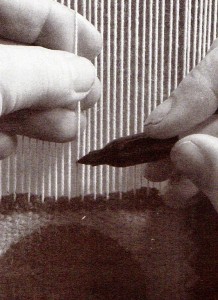 ink circle can become distorted as the warps shift and turn in the weaving process. So, keep the cartoon close or make a template that you can check the circle against. Also, there are right ways and not so good ways to ink. You always want the finest line possible and the ink to go all away around the warp. Use a very sharp pen-hold only the very tip against the warp and turn the warp in your other fingers to get the ink around the warp. Do not use a juicy pen as the ink and wick up or down the warp. Use only tested water proof markers.
ink circle can become distorted as the warps shift and turn in the weaving process. So, keep the cartoon close or make a template that you can check the circle against. Also, there are right ways and not so good ways to ink. You always want the finest line possible and the ink to go all away around the warp. Use a very sharp pen-hold only the very tip against the warp and turn the warp in your other fingers to get the ink around the warp. Do not use a juicy pen as the ink and wick up or down the warp. Use only tested water proof markers.
To begin to weave- Weave the base half way up each side of the circle and stop. Make sure that you use the same pattern of turns and stair steps on both sides. If you change the number of passes using fewer or more the circle will no longer be round.
Now you have a couple of decisions to make especially if you don’t 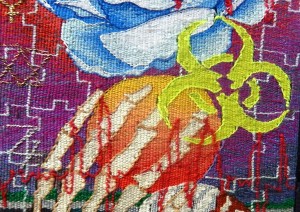 like stair steps or teeth in your circles. You can choose
like stair steps or teeth in your circles. You can choose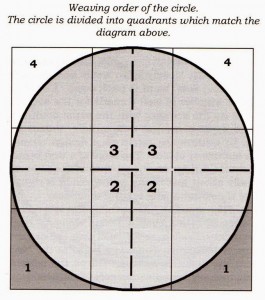 to split the weft or use soumack to smooth everything out. I generally use soumack. My soumack weft is usually one half of the weaving weft bundle because I don’t like ridges on my tapestry. You ca
to split the weft or use soumack to smooth everything out. I generally use soumack. My soumack weft is usually one half of the weaving weft bundle because I don’t like ridges on my tapestry. You ca![]() n choose the weft to be in the colour of the base colour or the colour of the circle. If need be to continue the coloured soumack weft one can lace up the sides of the slits. But, One can only soumack so far up the sides and across the bottom before the distance the soumack weft travels across the warps and up begins to look loopy. At this point I stop the soumack and then pay attention to full threads and hollow threads as I weave. I often jump up with the weft
n choose the weft to be in the colour of the base colour or the colour of the circle. If need be to continue the coloured soumack weft one can lace up the sides of the slits. But, One can only soumack so far up the sides and across the bottom before the distance the soumack weft travels across the warps and up begins to look loopy. At this point I stop the soumack and then pay attention to full threads and hollow threads as I weave. I often jump up with the weft 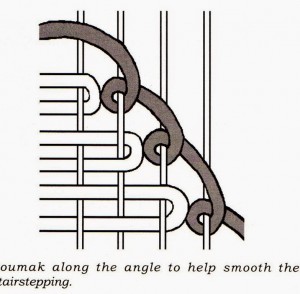 turns to pull off
turns to pull off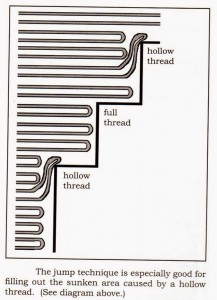 the tooth. I weave the first half of the circle.
the tooth. I weave the first half of the circle.
To end the circle or do the last half one weaves the inner circle in the same way or reverse the stair steps-BUT it is the same pattern of climbs that
I began with the first half of the circle.
I will also weave the circle slightly taller. About 5 percent above the cartoon to take into account the squish factor. I then outline the circle in soumack and fill in the out side bases of the circle paying attention to the hollow and full threads as I ascend up the sides and over the circle. Once the soumack happens at the top it will round the circle and get rid of any teeth or stair steps.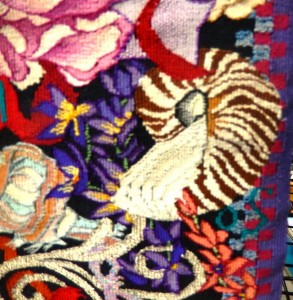 A couple of things to be aware of as you weave and beat the bottom part of the circle it will have a tendency to widen out while the top of the circle will have a tendency to pull the warps in. Once you reach the top half of the circle you no longer have the base or out side to follow. You will be dependent on the cartoon and inking to keep the circle round.
A couple of things to be aware of as you weave and beat the bottom part of the circle it will have a tendency to widen out while the top of the circle will have a tendency to pull the warps in. Once you reach the top half of the circle you no longer have the base or out side to follow. You will be dependent on the cartoon and inking to keep the circle round.
Don’t stop checking the circle. Trust your eye rather then your markings which can shift and stretch as the warp relaxes from being worked. Generally weave slightly over the the inking. The other thing– this is not a good time to tighten or mess with the tension of the loom. Begin with the tension being tight.
The other thing to remember is that circles have a tendency to loose height when the tension is taken off of the weaving so compensate accordingly. Remember that circles do have a tendency to pull in as the top half is woven. Watch for consistency in the bubble of the weft while you are weaving. Use more weft if it starts to pull in. Less weft in the bubble in the areas next to the area that is pulling in. A major error that I see all the time is as it begins to pull in the weaver suddenly begins to use way to much weft in the pulled in area and they get vertical ridging, If this happens use less weft in the weft bundle and more in the areas next to the pulled in area to it will correct easily. Those vertical ridges will not go away with ironing etc. And if you can get them out they leave a blister or bubble in the tapestry.
Weaving circles is much more detailed in my book tapestry 101. In my Tapestry 101 book I actually describe several other methods for weaving circles without stair steps and teeth. There are also some 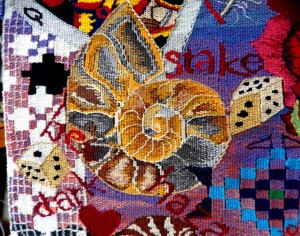 weaving corrections for making circles rounder by using the inside or circle weft passes in different ways to force the circle to be more round. The illustrations in this book were done by Pat Spark. Please do not abuse the copy right of these pictures.
weaving corrections for making circles rounder by using the inside or circle weft passes in different ways to force the circle to be more round. The illustrations in this book were done by Pat Spark. Please do not abuse the copy right of these pictures.
Guess that’s all for now!
kathe